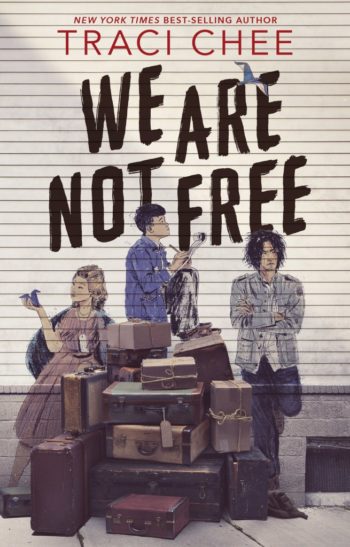
Guest Post & Giveaway: We Are Not Free by Traci Chee
We Are Not Free by Traci Chee just recently released this Tuesday September 1st, and we couldn’t be more excited for everyone to read this powerful novel! Finding the voice and heart of the 14 teenagers’ stories in We Are Not Free must have been quite a journey and so we asked Traci to share some of her inspiration with on how one of her characters came to be.

We Are Not Free
by Traci CheePublished by: HMH Books for Young Readers
on September 1, 2020
Genres: Young Adult, Historical Fiction
Goodreads
“All around me, my friends are talking, joking, laughing. Outside is the camp, the barbed wire, the guard towers, the city, the country that hates us. We are not free. But we are not alone.”
From New York Times best-selling and acclaimed author Traci Chee comes We Are Not Free, the collective account of a tight-knit group of young Nisei, second-generation Japanese American citizens, whose lives are irrevocably changed by the mass U.S. incarcerations of World War II. Fourteen teens who have grown up together in Japantown, San Francisco. Fourteen teens who form a community and a family, as interconnected as they are conflicted. Fourteen teens whose lives are turned upside down when over 100,000 people of Japanese ancestry are removed from their homes and forced into desolate incarceration camps. In a world that seems determined to hate them, these young Nisei must rally together as racism and injustice threaten to pull them apart.
Guest Post
We Are Not Free is a YA historical that follows a group of fourteen Japanese-American teenagers as their lives are irrevocably changed by the mass incarcerations of WWII. As a novel-in-stories, the book features a new character every chapter, and every character offers readers a window into a different aspect of the eviction and incarceration that affected more than 100,000 people of Japanese ancestry in the US. The first three chapters are concerned with the unmitigated racism Japanese Americans faced in the months following Pearl Harbor, the mass eviction that ousted so many families from their homes on the west coast, and the temporary detention centers where incarcerees were held before being shipped to more permanent camps farther inland.
Then we have the incarceration camps, where more than 100,000 people were imprisoned for three years behind barbed wire fences for crimes they had not committed. And here we have Bette Nakano—fun, flirty, whip-smart, and ambitious. Starting with the train ride from California to the incarceration camp in Utah, she’s dead-set on having a life of glamor and grandeur, and nothing—not the federal government, not a little food poisoning, and certainly not the lack of a band for the camp dance—is going to stop her. Her chapter shows readers what conditions were like in the early days of camp: the dust, the cold nights, the problems with heating and hot water, the subpar food, the lack of school facilities and supplies. I think it would have been obvious to write a chapter that dwelled on the bleakness of camp conditions, and Bette touches on these, of course, but she’s not in the business of dwelling, so she sees every little aspect of camp with an eye toward beauty and optimism.
Actually, Bette’s indomitable spirit are somewhat inspired by my grandmother, who was incarcerated when she was thirteen. My grandma passed away long before I could ask her about her experiences in camp, but according to her older sister, she embraced camp life with a kind of wild and enviable gusto: running around with her friends, dating a variety of hapless boys, borrowing her sister’s dresses to go out at night. From what I can tell, she took one look at these awful conditions, said, “I don’t think so,” and with a mixture of aspiration, inspiration, and good old-fashioned craftiness, spun them into these tempestuous, romantic years the likes of which you might find in some splashy big-screen period piece.
I wanted to capture that spirit, not just because it makes a good story, but because I’m not interested in dwelling either. Bette isn’t a naïve girl—she clearly knows her situation is bleak—but the thing is, she isn’t going to let that stop her from living. And depicting this ferocious joy was just as important to me as depicting the sadness, anger, and resentment of the previous three chapters, or the frustration and cynicism of the following ones. Because this kind of joy existed in camp, too, and these kinds of stories need to be told so that the experiences of people like Bette and my grandmother aren’t erased and absorbed into one flat narrative about the suffering of Japanese Americans during the incarceration. This happened to real people, and they weren’t all one thing. They were sad and resigned and bitter, yes, of course. But they were also young and rebellious and determined and exuberant! They were full of complications and contradictions, and if we’re going to understand them and remember them and honor them, I think we need to see all these different sides of their experiences, and, as Bette would want us to do, celebrate them.
Giveaway
Win this or any new release featured in September. Open international so long as Book Depository ships to you!
a Rafflecopter giveaway
.












[…] Head over to Bookcrushin’ for a chance to win Any New Release Featured there This Month […]
[…] Head over to Bookcrushin’ for a chance to win Any New Release Featured there This Month […]
[…] Head over to Bookcrushin’ for a chance to win Any New Release Featured there This Month […]